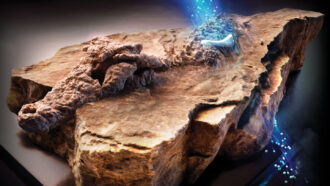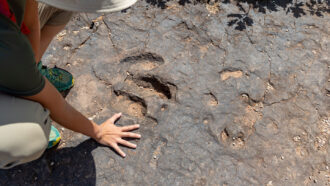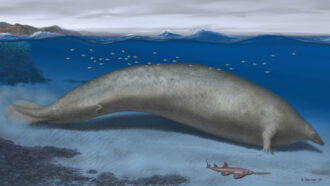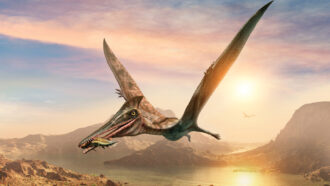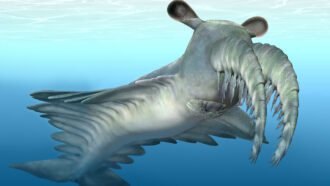Early tyrannosaurs would have feared this predator
Siats meekerorum probably kept early relatives of T. rex from evolving into giant predators themselves
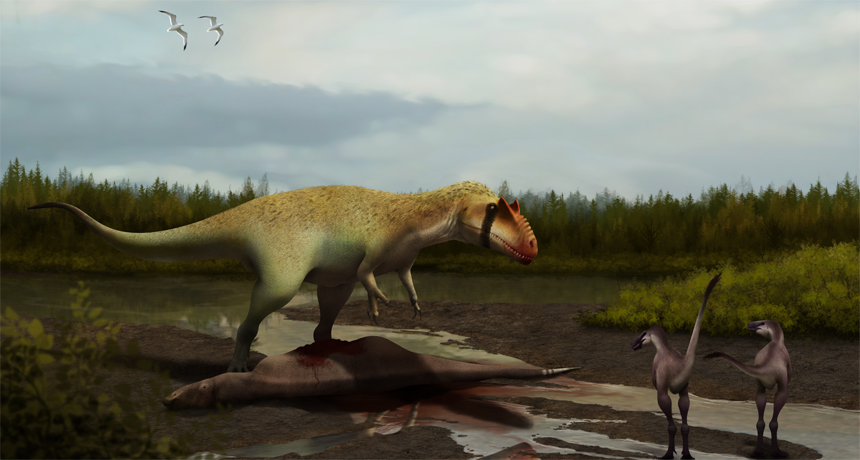
Siats meekerorum stands over a carcass of its prey. Scientists suspect this enormous predator kept the relatively teeny tyrannosaurs of that era (foreground) from evolving into large and dominating predators.
Julio Lacerda
By Sid Perkins
Tyrannosaurus rex was one of the most fearsome creatures to walk the planet. Some 65 million years ago, this 12-meter (40-foot) long meat-eating dinosaur chomped its prey using teeth the size of bananas. Yet scientists have wondered why its ancestors remained relatively small for millions of years. Now, the discovery of a new meat eater may offer some answers. This newfound predator may have preyed on T. rex’s ancestors. That should have kept them small and on the run.
Scientists call the new dino Siats meekerorum (SEE-atch ME kur OR um). Its genus name comes from the native American Ute language, where tribal legend describes a man-eating monster named Siats. The new dino’s species name honors the Meeker family. (It has sponsored research by young paleontologists working at the Field Museum in Chicago. That’s where the researchers who describe the Siats fossils worked when they first unearthed its bones in Utah.)
Like T. rex and its tyrannosaur kin, Siats walked on two legs. But Siats belonged to a different family, the allosaurs. Named for its best known species — Allosaurus — these carnivores come from a different branch of the dinosaur family tree than tyrannosaurs.
S. meekerorum ruled what is now western North America about 98.5 million years ago. Its discovery helps fill a large and mysterious gap in the fossil record, notes Lindsay Zanno. She’s a vertebrate paleontologist at the North Carolina Museum of Natural History in Raleigh. She and her co-workers announced the new allosaur species in a paper. It appeared online Nov. 22 in Nature Communications.
Before researchers dug up the remains of Siats, no large predator was known to live in western North America between 110 million years ago and about 80 million years ago (when tyrannosaur ancestors of T. rex started becoming large).
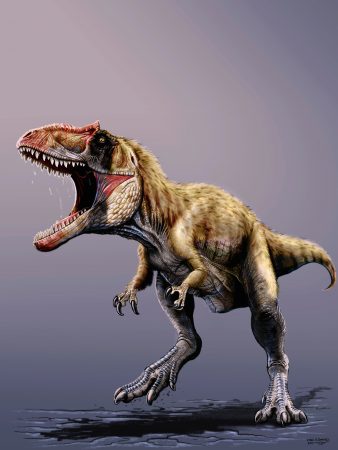
Zanno and her team estimate that Siats weighed more than 3,900 kilograms (8,600 pounds). Most of the fossil remains they found came from an individual that likely measured more than 9 meters (about 30 feet) long. But it also was only a juvenile when it died. Its towering size makes Siats the third-largest known predator to ever prowl western North America.
Its dominance also may explain why tyrannosaurs remained relatively small for millions of years — through a period when they would have been expected to evolve into towering threats. The presence of an enormous allosaur would have left little opportunity for teeny tyrannosaurs to move on up to top-predator status.
These huge predatory allosaurs “were the cap that kept tyrannosaurs from becoming dominant,” concludes Thomas R. Holtz, Jr. He’s a vertebrate paleontologist at the University of Maryland in College Park.
Researchers aren’t yet sure what ecosystem change triggered the demotion of allosaurs from being their ecosystem’s top dogs. “We don’t have enough evidence to say why the ecosystems changed,” says Holtz. “We also don’t know if the change was gradual or catastrophic.”
The Siats discovery does narrow the window of time during which tyrannosaurs came to power. Siats strolled western North America some 98 million years ago. Within the next 18 million years, a tyrannosaur called Lythronax — or King of Gore — rose to apex status. Lythronax might have reached lengths greater than 10.5 meters, or roughly 35 feet.
By digging up more fossils from rocks deposited during that 18-million-year window, scientists hope to solve the mystery of how tyrannosaurs dethroned allosaurs. And that, of course, made way for the rise of the king of them all: T. rex.
Power Words
allosaurs (also known as allosauroids)A group of two-legged, meat-eating dinosaurs named for one of its oldest species, Allosaurus.
carnivore An animal that either exclusively or primarily eats other animals.
Cretaceous A geologic time period that included the end of the Age of Dinosaurs. It ran from roughly 145.5 million years ago until 65.5 million years ago.
evolution (verb: evolve) A process by which species undergo changes over time, usually through genetic variation and natural selection, that leave a new type of organism better suited for its environment than the earlier type. The newer type is not necessarily more “advanced,” just better adapted to the conditions in which it developed.
fossil Any preserved remains or traces of ancient life. There are many different types of fossils: The bones and other body parts of dinosaurs are called “body fossils.” Things like footprints are called “trace fossils.” Even specimens of dinosaur poop are fossils.
Jurassic Lasting from about 200 million to 145.5 million years ago, it’s the middle period of the Mesozoic Era, a time when dinosaurs were the dominant form of life on land.
paleontology The branch of science concerned with ancient, fossilized animals and plants.
predator A creature that preys on other animals for most or all of its food.
prey Animal species eaten by others.
theropod A meat-eating dinosaur of a group whose members are typically bipedal (walk on two legs) and range from small and delicately built to very large.
tyrannosaur A line of meat-eating dinosaurs that began during the late Jurassic Period, about 150 million years ago. These theropod species persisted into the late Cretaceous Period, about 65 million years ago. The best known member of these species: the late Cretaceous’ Tyrannosaurus rex, a 12-meter (40 foot) long top predator of its time. (Tyrannosaurs and allosauroids are different branches of the dinosaur family tree.)
Ute A group of Native Americans, now living primarily in Utah and Colorado.
vertebrate An animal that has a long backbone or spinal column. Vertebrates include mammals, birds, reptiles, amphibians and fish.


